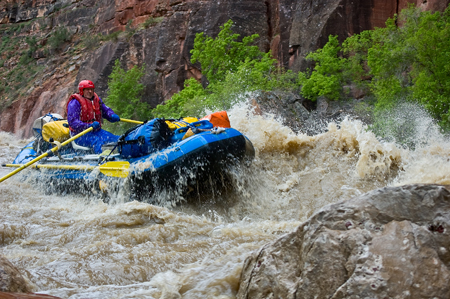
Dale in Warm Springs rapid.
When I saw the gaping maw of the hole near the bottom of Warm Springs rapid, it occurred to me that I might be better off not being in any boat that had even a slight chance of going in there.
When the two park rangers recommended we portage two of the boats, watching the carnage from the shore became even more attractive.
When the second boat down the rapid flipped in the hole and the upside-down raft and its captain disappeared around the bend, I knew I would be walking around the beast.
It was day three of rafting the Yampa River in northwestern Colorado. I had taken a brief swim in the chilly, brown water the day before and didn’t want to repeat that experience.
We launched from Deerlodge Park on the eastern tip of Dinosaur National Monument into a river barely contained in its banks. The silty water was the color of heavily creamed coffee and carried trash, lumber, brush, and whole trees even. And dead animals: goats, cows, deer, etc. We had 18 people in 8 boats and would be out five days and four nights, May 21-25.
We spent a day and half in the Deerlodge campground rigging boats and running the shuttle under glorious skies and temperatures in the 70s and 80s. We left the comfy weather and luxurious pit toilets behind when we hit the river.

Dale hanging out just before launch.
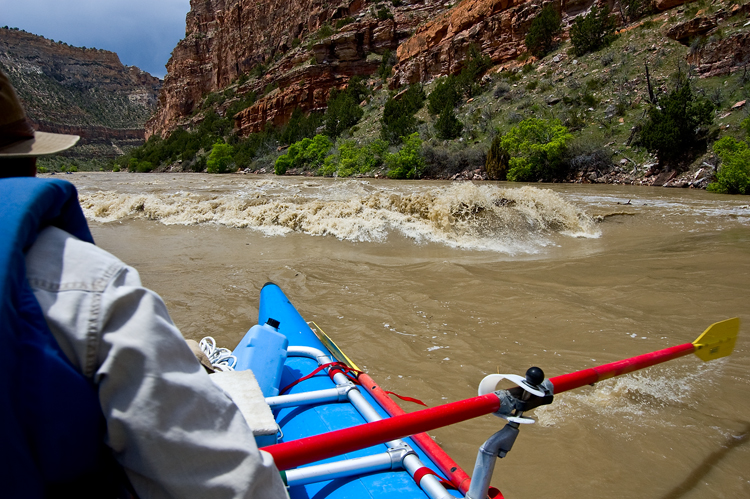
Some of the “flat” water from the first day. Click on the pictures to see them larger. Go to Flickr to see more photos of the trip.
Day 1 was supposed to be flat water — good for watching the scenery and taking pictures — but flowing at around 18,000 cubic feet per second, the water was little more vertical than usual. Average water flows in the spring are around 8,000 to 10,000 cfs, but a huge snowpack and several warm days combined for a big snowmelt. The water was about 50 degrees. Wet suit conditions. I rode on the rumble seat of my Dad’s 16-foot blue Hyside cataraft. He originally installed the seat so Mom wouldn’t have to sit on an ice chest or some other gear. It’s quite comfortable and affords a great view of the river.
I thought the river was just a little higher than what these guys usually run. I didn’t realize it was unusually large until the last day when I heard a few of the guys talking about how big the water was. Dad said it was the biggest water he’d ever had his boat in, and the biggest water he’d been in except for his trip down the Grand Canyon in 1997 when he rode in another guy’s boat.
The Yampa Canyon is a scenic wonder. Sandstone cliff walls rise straight up out the water in many places and soar over 1,500 feet in some spots. It’s a classic high desert landscape. Junipers and fragrant sage with some cactus and wildflowers grow from the sandy soil.
Oh, and it is a land of turds. Poop is everywhere. Deer poop. Elk poop. Antelope poop. Coyote poop. I guess it’s because it’s a desert and it takes a long time for things to decompose. We also saw carcasses all over the place. Again, the decomposition-taking-a-long-time thing, I guess. On our drive to Deerlodge, we saw at least five dead antelopes hanging from fences. I don’t know how they got there.
Despite the unexpected vigor of the rapids, it was an easy and fun day and we pulled into the beautiful Ponderosa campground and the work began. It turns out a rafting trip is about 20 percent rafting and 80 percent work, especially when the river is so high that the boats travel twice as fast as expected. When you hit a campsite there’s the group work: unpacking boats, hauling gear, setting up the kitchen and completing your assigned chores. Then there’s the work of setting up your little camp: putting up the tent, blowing up the air mattress, situating the sleeping bag.
Then you do all that stuff in reverse in the morning.
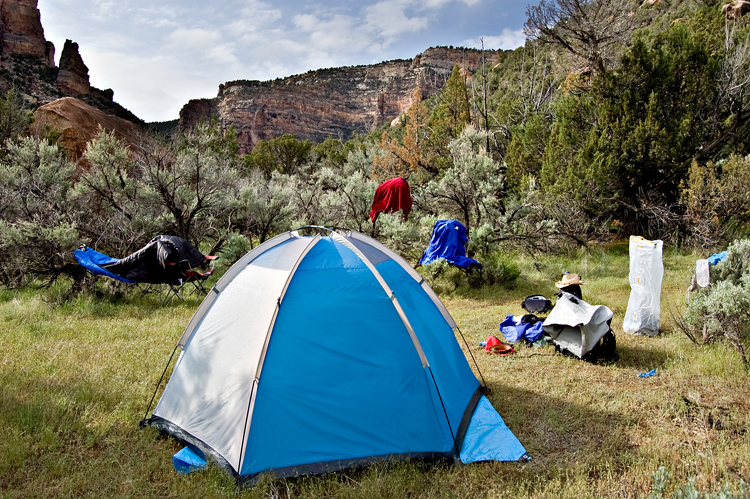
Camp Soggy at Ponderosa. Note the stuff I hung up to dry on the sagebrush.

The boats tied up at Ponderosa.
The rain that would continue off and on for the duration started that afternoon and added another task to the work list: figuring out some way to dry your clothes.
On this trip, the time spent off the water was even greater because the river was so high and moving so fast that the expected travel times were compacted.
The real rapids awaited on Day 2 and Dad and I walked downstream to check out the top of Teepee rapid, a Class III rapid that had a good-sized hole right at the beginning. Dad explained to me how the hole had a keeper side on the right where the water was recirculating instead of bending on downstream. That side would tend to hold any boat that strayed that way. Hmmm, I hoped he kept that in mind.
I woke up the next morning after a night in the fetal position in an attempted to avoid touching the sides of the tent and channeling the incessant rain inside to soak my sleeping bag. During the night I had spread out a towel to soak up the water that ran unimpeded through the door zipper and down to the tent floor. I later added a pair of pants and two socks to supplement the soaking power of the towel. It worked pretty well.
As we loaded up in a heavy rain, Dad said he wanted to get behind Dale as that is his usual spot on these trips. We hit Teepee right off the bat and I watched as Dale headed right for the keeper side of the big hole. The boat stood up on its edge and Dale was tossed into the churning water. We chased after him but never could catch him. Marty and Dave plucked him out of the water after a swim of probably less than a mile. He later said the incident served to sharpen his focus. It made me wonder why Dad wanted to follow him.
I got my own focus sharpener about an hour and half later near the bottom of Big Joe rapid. We went through the rapid with little problem and, thinking the ride was just about over, I relaxed and stopped holding on. A big wave lifted the boat up from the left side and water came over the tube and washed me right off the back of the boat.
The boat was way up on top of the wave and I was looking up at it. In the next instant I went up the wave and suddenly I was even with the right tube. I grabbed on and Dad said, “Just hang on.” I said something along the lines of “If you don’t mind, my good sir, I think I’ll climb back into the boat where I’ll feel much safer than down here in the water.” I pulled myself out and plopped back down in my seat. I probably wasn’t in the water more than 20 seconds. Unfortunately, the river claimed my sweet wide-brimmed Panama Jack straw hat I bought at Wal-Mart for 10 bucks. I failed to accessorize it with a chin strap.
It turned out that Barb had come out of the paddle boat somewhere along the way, too. Three swimmers in one day. Apparently, that’s unusual, but I didn’t know any better.
We made 17 miles in two hours. It was expected to take four hours or so. We had plenty of time to do off-river stuff that afternoon, so Heather, Anita, Chrissy, Barb, Dale, Bill, Dick, Dad and I hiked up Bull Canyon to see the cave at the end of the trail.
Dad had printed out a ton of stuff from the Internets and placed it in a manila folder, which he brought on the hike. His information indicated that the ancient Fremont people had painted scenes of their daily life in a cave in the area. The information said to hike to the top of Bull Canyon to see the cave. (Dad’s apparently thorough knowledge of things and his manila folder earned him the nickname “Professor Fremont” from one of the girls.)
So we hiked and hiked and hiked. We hiked through sunshine, blustery rain and a short hail storm. It eventually became clear there was not going to be a cave at the end of the hike. When we topped out on the canyon rim, we realized what was going on. From way up there we could see the cave across the river from our campground about 100 miles away. The hike was to an overlook of the Fremont people’s cave. Well, you can plainly see the cave from the campsite. You don’t need to take a three-hour hike to see it. The water was so high, we couldn’t take a boat across the river, so we couldn’t actually go inside the cave.

Heather at the top of Bull Canyon. Can you spot the cave? It’s on the far right. And tiny.
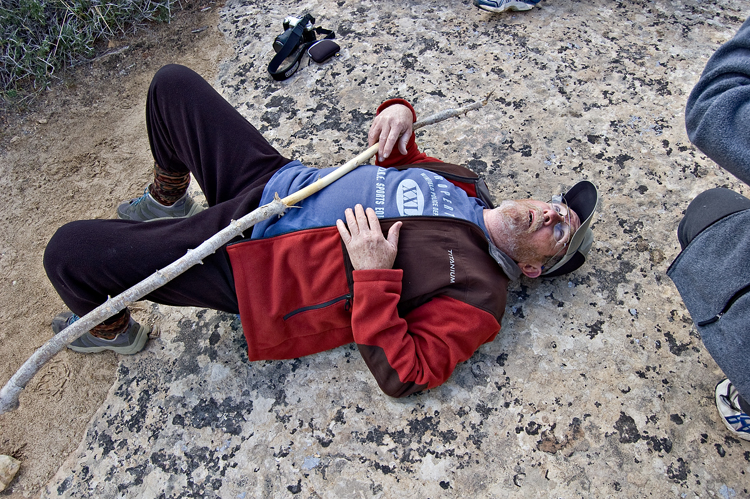
Dick collapsed for a short rest at the top.

The explorers at the top of Bull Canyon.
But the hike was worth it. On the way back down the canyon, Heather, Anita, Dad and I climbed up on a sort of a rock spire. When the canyon was formed this chunk of rock remained while everything else eroded away. It looked like an island in the sky. It had soil, grass and brush on top, which was 100 feet or so above the canyon floor. And it was the only place I saw on the whole trip that wasn’t covered in poop.
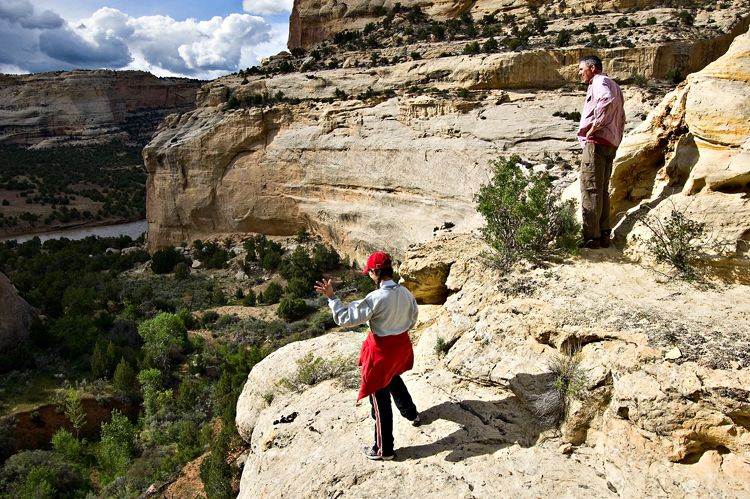
Dad and Anita on top of the rock island in the middle of Bull Canyon. I think Anita is waving to other members of the expedition far below.
That night we learned Anita is quite a singer. She sang a John Prine song and then the chorus to Seven Spanish Angels, but nobody could remember the rest of the words. She ended on a song she wrote herself. Everyone was spellbound there for a few minutes. Maybe we’ll see her on American Idol sometime.
We got some more good rain during the night and we headed out the next day in cloudy and cold weather to meet Warm Springs rapid. That morning’s float took us through the most spectacular scenery of the trip. We came around a bend in the river and saw fresh snow on mountains in the distance. The canyon walls towered all along the river and the water was truly flat. I should have had my camera out, but because we didn’t know if the water would be rough, I packed it away deep in a dry bag.
One section of the canyon was called the grand overhang. The sandstone cliff rose straight out of the water and soared 1,000 to 1,500 feet and actually overhung the river. Professor Fremont’s research revealed that a rock dropped from the top would splash down in the middle of the river.
That brings us back to Warm Springs.
There was a monster wave train on the left side against a cliff wall with a giant, giant hole near the bottom of the rapid in the left center. The run was down the right side to avoid the hole, but there was a huge lateral wave above the hole that would try to shove the boat to the center. Just beyond that wave was a big rock and a smaller lateral. The run was to go down the tongue and backstroke like holy hell to break the eddy line on the right side. Then you had to turn the boat to break the first lateral head-on. But if you were too far right you could break the lateral and hit the rock behind it. If the boat was far enough right, it would miss the hole and glide on to the end of the rapid.
Our park ranger friends, Ranger Doug and Ranger Phil, who had been more or less running the river along with us, came up as we were examining the rapid. Doug had stopped by our camp that morning and said the river was running at 23,000 cfs and that the campground at Deerlodge Park was under water. The rangers suggested we portage the paddle boat and the smaller cataraft Jo Ellen was rowing. The paddle boat folks breathed a sigh of relief, and, since others weren’t going to run the rapid, I decided that I could skip it, too. Besides, it would give me a chance to shoot some pictures of actual rafting.
The rangers told us to station people downstream with throw bags and to set up the two portaged boats as chase boats in case someone got into trouble. It was a long haul over huge boulders, but we got the boats and all the gear down the bank and reassembled and back in the water in an hour or so.
Ranger Doug ran it first in his government-issued boat and caught a piece of the hole but was OK. Our Phil ran next and did the same as the ranger. A thunderstorm blew in as we were waiting for the next boat. Hail started to fall, stinging the back of my neck. Ranger Phil remarked he was glad he had his river-running helmet on.
Herb came next. I don’t know what happened, but he was off the line and the hole just ate his boat. The raft flipped and Herb was in the cold water for a mile or so before Phil caught up to him. After seeing that, I thought more boats than not were going to flip. But everyone else ran the rapid without major mishap. Dale ran it with extreme aplomb. Unlike the others, he missed the hole completely. I was completely amazed at these guys. It takes some cojones to row one of those huge, heavily laden rafts into water like that.
(You can see the photos I shot of the runs down the rapid over at Flickr. Dad ran second to last and the ranger told me to get down to my boat so I wouldn’t be left behind, so I didn’t get to shoot any of Marty. Sorry Marty.)
I got to the boat and we headed out for the campsite at Boxelder. Herb and Phil had lassoed Herb’s boat, but the strong current wouldn’t let them do anything with it. When they came to that night’s campsite, they steered the boat into a big log just to stop it. Herb was standing on the bottom of the upside-down boat when we got there. Eventually ropes were attached to the boat and we heaved it off the log. Then a few folks grabbed the special flip ropes and got the boat upright, but it flipped up onto the bank. Ranger Doug, who was a real wit, said “We’ve got to do something about the landing at Boxelder.”
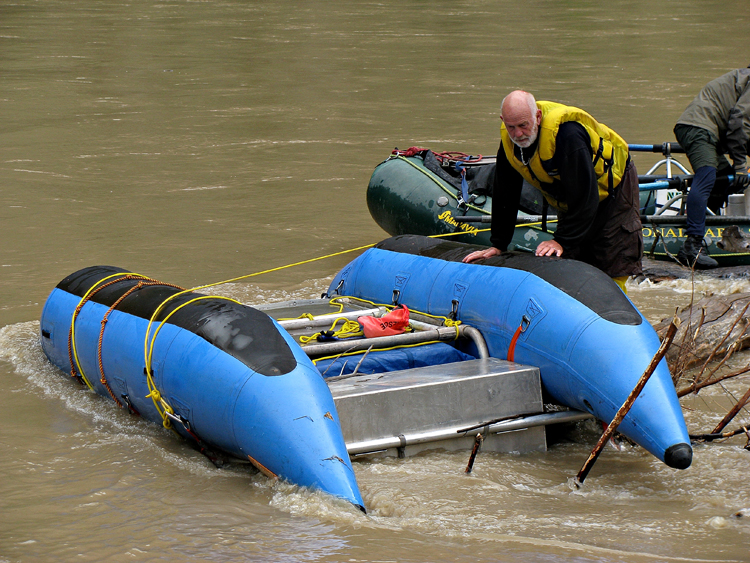
Herb working to free his boat.
It rained some more that night.
With Warm Springs behind us, we headed down to the confluence of the Yampa and Green rivers and Whirlpool Canyon. The Green River, which is dam controlled, was running very low. Almost all the water in the Green below the Yampa’s mouth came from the Yampa.
Several of us took a short hike at Echo Park to see the ancient petroglyphs. The glyphs were very cool, but very faint. I knew they would never show up in a picture.
Whirlpool Canyon was very cool. The rapids weren’t big, but it was filled with strange eddies and the water would rise up randomly in big boils and whirlpools. Again, we didn’t know what the water would be like, so the cameras were tucked away.
We spent our last night in Island Park, where the river runs across a big flat plain. It splits up into several channels, creating the islands. As we slowly drifted, we watched for the famous bison petroglyph on one of the rock walls and finally saw it. Even though the skies were clear, it actually rained on us that night. I don’t know where it came from. It was weird.
The last day was probably the shortest run and the most fun. Before we entered the last canyon we drifted down a stretch of calm water. It was one of the few times on the trip when it wasn’t raining or blowing and the river was quiet. The only sounds where the paddles and oars dipping in and out. Ahead of us in the paddle boat Anita began singing. I don’t know what the song was, I couldn’t make out the words. It might’ve been a happy song, but it sounded sad and lonesome to me. It was Abby’s birthday that day and I was wishing I was at home with her. The quiet setting, Anita’s singing and missing Abby’s birthday put a big lump in my throat.
Finally we hit the rapids. I shook off my melancholy and concentrated on holding on. The last five or six miles of the trip through Split Mountain Gorge were the best, in my opinion. Big rapids one right after another. Some of the waves were six feet high for sure, and I think some might have eight feet. Everyone made it through upright. Before I knew it it was over.
But we still had trouble. When herb flipped he lost only one piece of gear: an ammo box with the keys to the U-Haul truck that toted most of equipment. U-Haul, showing a shocking lack of customer service, said we’d have to have our own replacement key made. It was Sunday and Memorial Day weekend so finding a locksmith to cut a key proved difficult. Scott found one in Steamboat Springs 160 miles away.
Some of us started out for Colorado Springs immediately, getting there about midnight. The U-Haul riders didn’t get in until 3 a.m.
I didn’t even realize how much fun the whole thing had been — rain, cold, terror and all — until the trip was over. I can see how these guys get hooked on it. The folks who organized the trip, Scott, Gary, Jo Ellen, et al did a fantastic job. All the logistics and food and travel were taken care of. All I had to do were my assigned chores and set up my little camp. It’s a great way to go. I recommend it.
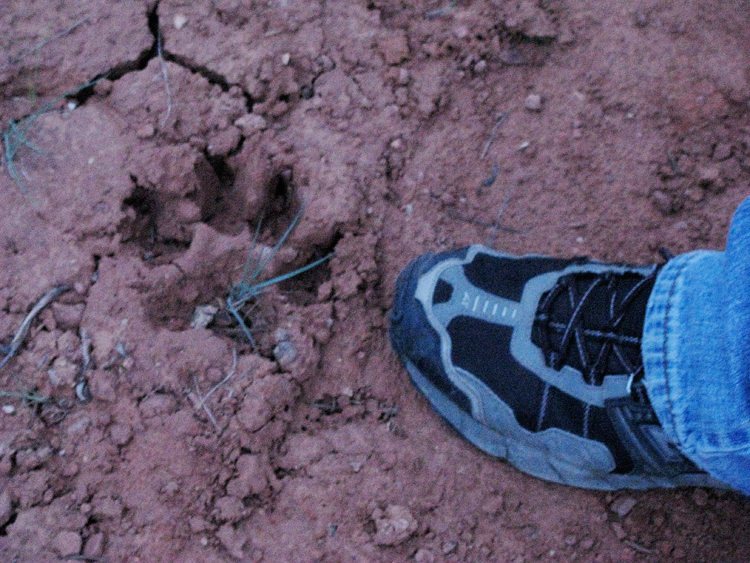
Track of the mighty puma that Dad and I came across in the the near dark 2 miles from camp.
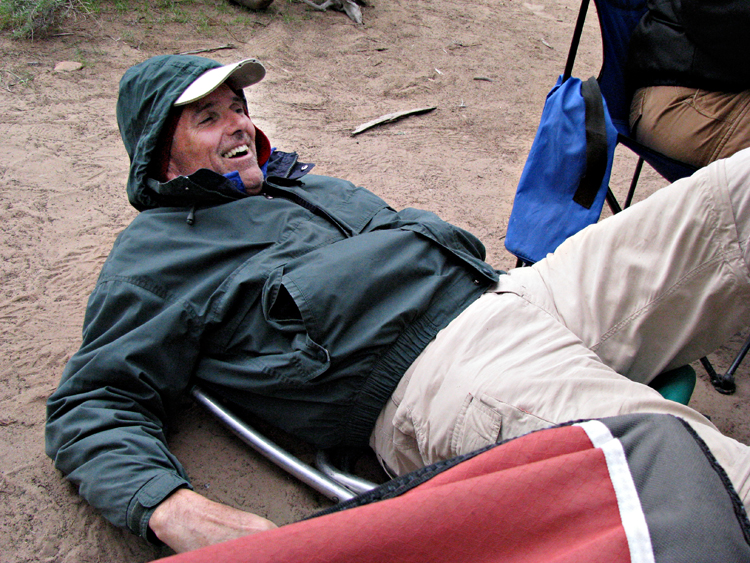
Dad’s decade-old camp chair gave way in camp one night.
Map of the pictures I uploaded to Flickr.
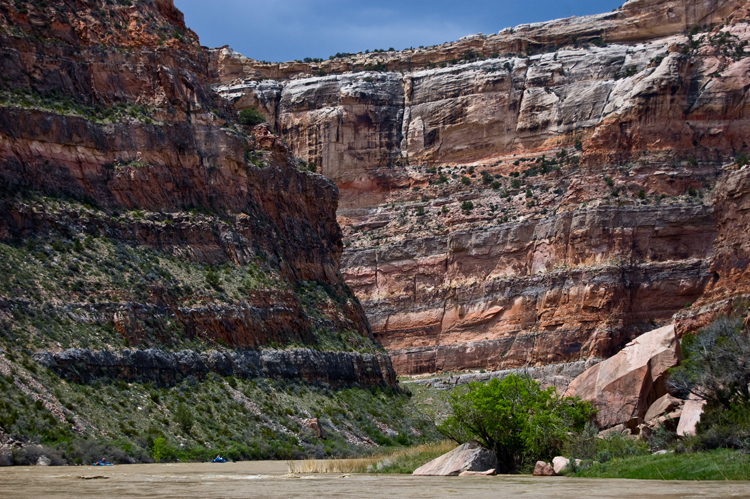
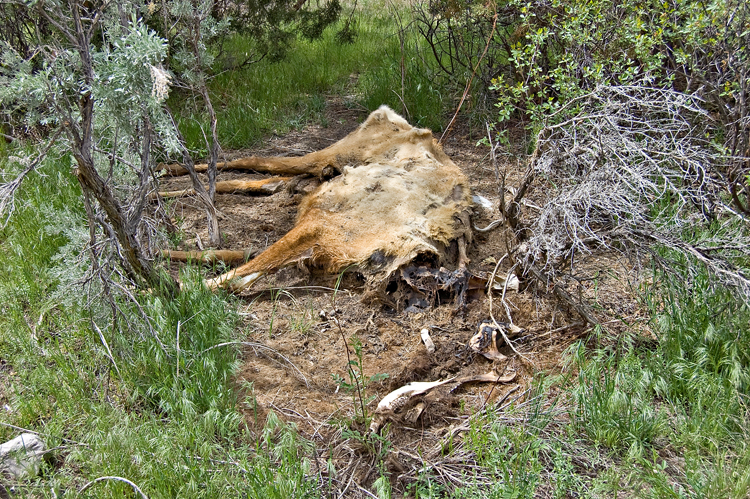
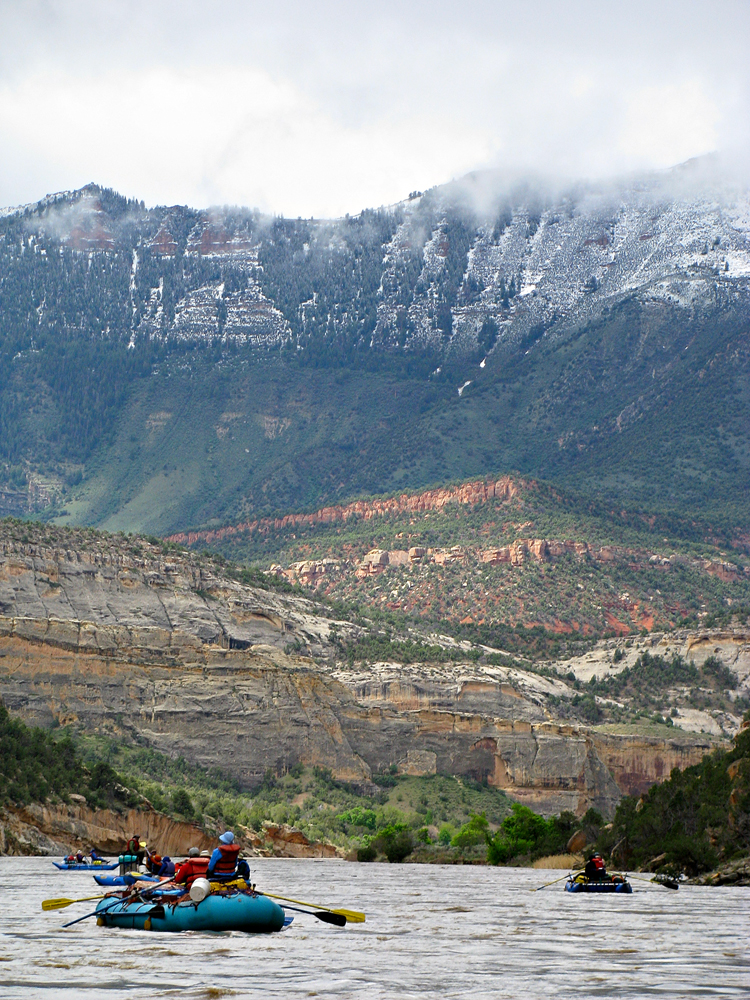
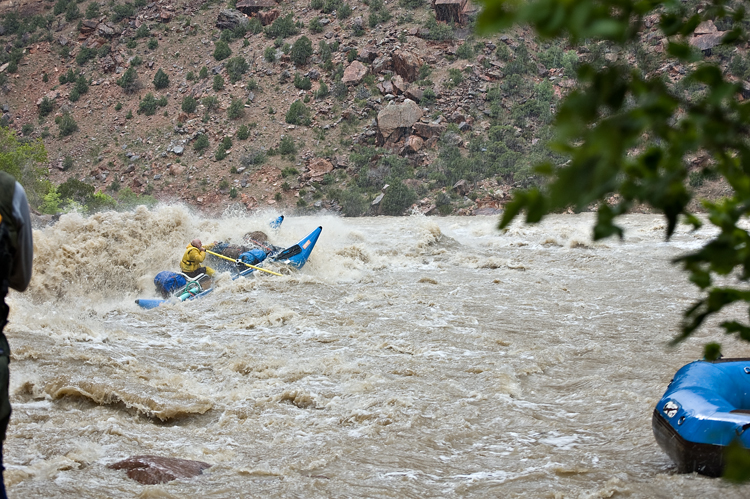

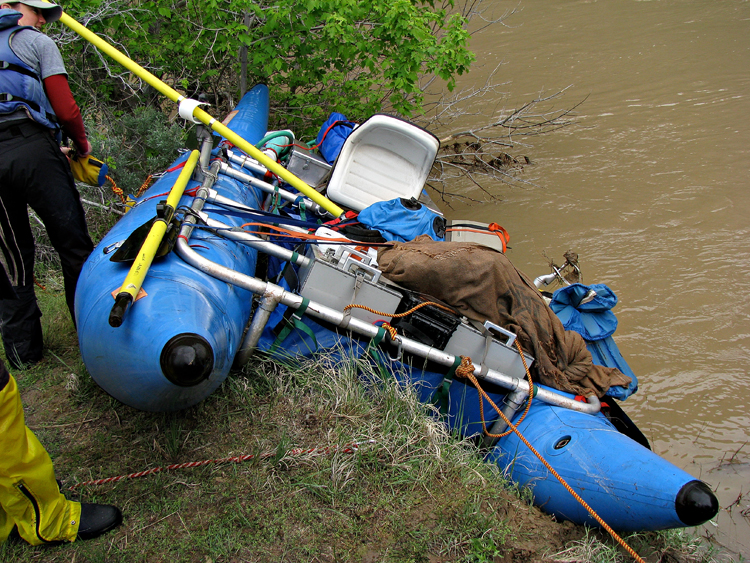

Comments
nice story. makes me feel like i didn’t miss all the action. the trip i went on had many many many days of flatwater and only one decent rapid, but no rain so maybe i lucked out.
Chaz….You Rock!
good storytelling. i love a trip where you don’t realize it was fun until afterwards.
Great story and pictures!
I’m always frustrated when I try to describe a float to someone; here you have really captured the essence. I’m going to hand out copies of this when people ask me how the trip was.
Good read, sounded great.
Great report.
I agree with your dad, I can never describe these trips to anyone who hasn’t been on one.
Wow! waht a great feel you gave to describing your trip. So far all I have done is the Green from Mineral Bottoms to the Colorado in a 17′ kayak. I have just completed my El Tigre 17 ft with blunt noses and a 12 ft water line and 28″ tubes, the Monster I call it. I can’t hardly wait to get it on the river. We may do the Sand Island to Swasey Rapid in Deso and Grey canyons this Sept when the bugs are gone.
Thanks again